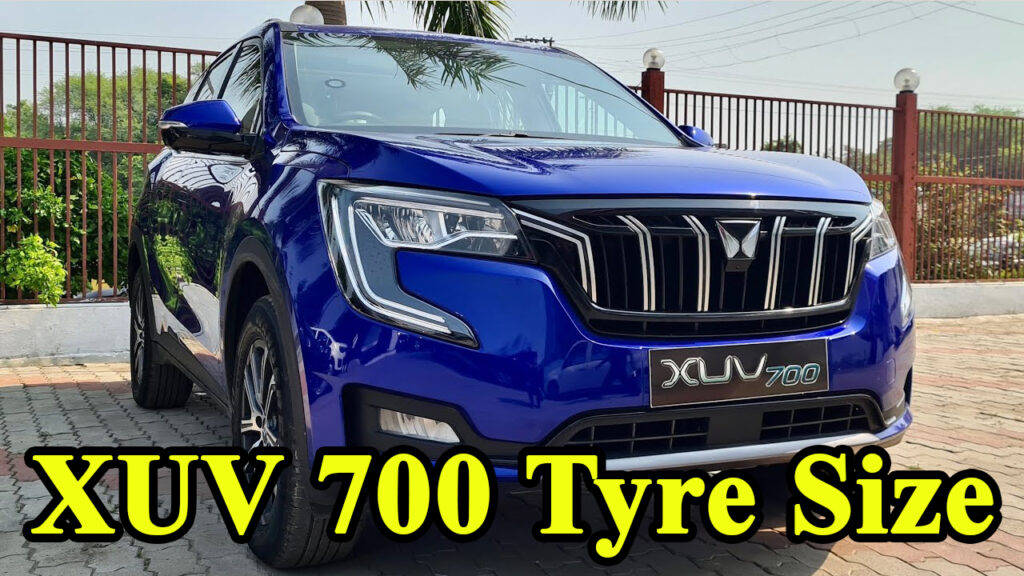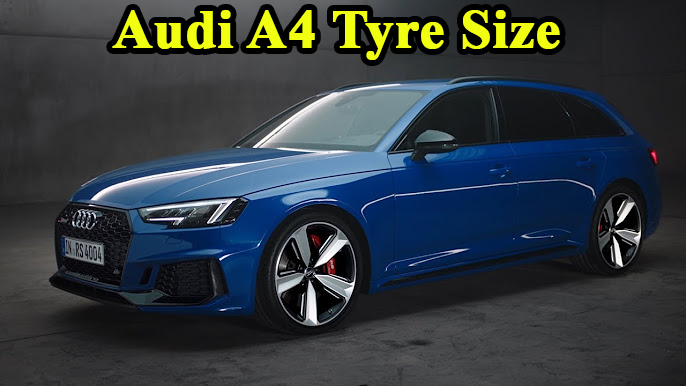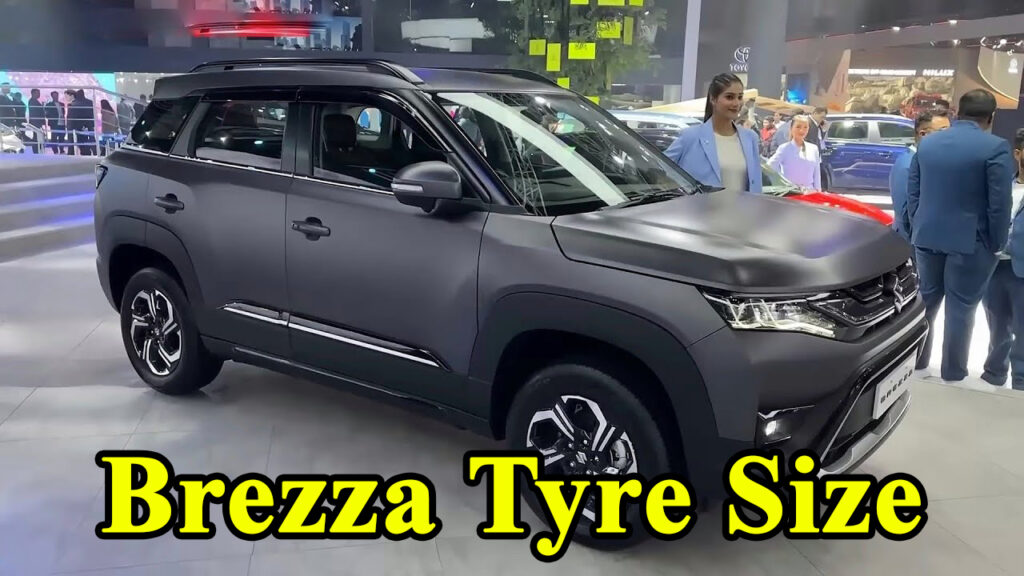XUV 700 Tyre Size: The Mahindra XUV700 has taken the Indian automotive market by storm, lauded for its feature-rich cabin, powerful engines, and impressive road presence. But as any seasoned driver or automotive enthusiast will tell you, a car is only as good as the tyres it rides on. They are the sole contact point with the road, influencing everything from comfort and handling to fuel efficiency and safety. So, if you own an XUV700 or are considering buying one, understanding its tyre sizes is paramount.
This article dives deep into the world of Mahindra XUV700 tyres, exploring the various sizes, their impact on performance, crucial aspects like tyre pressure, and even the best brands to consider for replacement or upgrades. We’ll demystify the technical jargon and provide insights that feel like they’re coming from a friend who truly knows cars, not just a textbook.
Understanding the Mahindra XUV700’s Tyre Landscape
Mahindra offers the XUV700 with two primary factory-fitted tyre sizes, catering to different variants and driving philosophies:
- 235/65 R17: This size is typically found on the lower and mid-range variants (MX, AX3, AX5).
- 235/60 R18: The higher-end variants (AX7, AX7L) come equipped with these larger tyres.
Let’s break down what these numbers and letters actually mean, because it’s more than just a random code:
- 235: This is the tyre width in millimeters. So, both factory sizes on the XUV700 have a width of 235mm, meaning a relatively wide contact patch with the road. This contributes to better grip and stability, especially around corners.
- 65 or 60: This is the aspect ratio, expressed as a percentage. It represents the height of the tyre’s sidewall as a percentage of its width.
- For the 235/65 R17, the sidewall height is 65% of 235mm. A higher aspect ratio generally means a taller sidewall, which acts as a better cushion against road imperfections, translating to a more comfortable ride. Think of it like a thicker rubber band around the wheel.
- For the 235/60 R18, the sidewall height is 60% of 235mm. A lower aspect ratio means a shorter sidewall. This typically offers sharper handling and better high-speed stability due to less sidewall flex, but it might lead to a slightly firmer ride, especially on uneven Indian roads.
- R: This simply stands for Radial construction, which is the most common type of tyre construction today. Radial tyres are known for their durability, better fuel efficiency, and cooler running temperatures.
- 17 or 18: This indicates the rim diameter in inches. So, the 235/65 R17 fits a 17-inch wheel, and the 235/60 R18 fits an 18-inch wheel. Larger wheel sizes often contribute to a sportier look and can accommodate larger brake discs, but they also mean a lower profile tyre (as seen in the aspect ratio) and potentially higher replacement costs.
Audi A4 Tyre Sizes: Your Ultimate Guide to Grip, Performance, and Peace of Mind
The Impact of Tyre Size on Driving Dynamics
It’s fascinating how a seemingly minor difference in tyre size can alter the entire driving experience. My own experience with various SUVs, including test drives of the XUV700 with both tyre options, has shown me this firsthand.
-
Ride Comfort:
- The 235/65 R17 setup, with its taller sidewall, undoubtedly offers a more forgiving ride. If you frequently drive on less-than-perfect city roads, or often venture out on highways with occasional rough patches (which, let’s be honest, is a common scenario in India), this size will absorb bumps and undulations more effectively. It makes long journeys feel less tiring. My friend, who recently took his AX5 variant on a road trip from Mumbai to Goa, raved about how comfortable the ride was, even over some of the broken stretches of NH48.
- The 235/60 R18, while providing a respectable level of comfort, will feel a touch firmer. You’ll notice those smaller undulations and sharper bumps a bit more. However, this is the trade-off for enhanced handling.
-
Handling and Stability:
- Here’s where the 235/60 R18 shines. The shorter sidewall means less flex, leading to a more direct and responsive steering feel. When you’re cornering at higher speeds, or making quick lane changes on the highway, the 18-inch tyres instill greater confidence. The XUV700 is a powerful SUV, and the AX7 and AX7L variants, with their higher power output, benefit from this enhanced stability. It feels more planted, more akin to a European SUV in its high-speed manners.
- The 235/65 R17 provides good, predictable handling for everyday driving, but it might exhibit a touch more body roll or a slightly less immediate response in spirited driving conditions compared to its larger sibling.
-
Fuel Efficiency:
- Generally, a wider tyre and a larger wheel diameter can slightly increase rolling resistance, which might lead to a marginal decrease in fuel efficiency. While Mahindra has engineered both setups for optimal performance, the 235/65 R17 might offer a minuscule edge in fuel economy due to its smaller overall diameter and lighter weight. However, the difference is often negligible in real-world driving and heavily dependent on driving style and road conditions. Mahindra claims mileage figures ranging from 13 to 17 km/l, which can be achieved with both tyre sizes under ideal conditions.
-
Braking Performance:
- Both tyre sizes offer excellent braking performance in the XUV700, thanks to its well-engineered braking system (ventilated disc brakes at the front and solid discs at the rear). A wider tyre (235mm in both cases) inherently provides a larger contact patch, which is beneficial for grip during braking. The XUV700’s advanced safety features like ABS and EBD work in tandem with the tyres to ensure confident stopping power. Some high-performance tyres, often available as aftermarket upgrades, can further reduce braking distances due to superior compound and tread design.
Important Values and What They Mean
Beyond the basic size, there are other crucial markings on your XUV700’s tyres:
- Load Index: This is a numerical code that indicates the maximum load (in kg) a tyre can carry at its maximum speed. For instance, a common load index for XUV700 tyres might be
104or103.104means a maximum load of 900 kg per tyre.103means a maximum load of 875 kg per tyre. It’s vital that your replacement tyres meet or exceed the vehicle’s original equipment (OE) load index to ensure safety, especially when the vehicle is fully loaded.
- Speed Rating: This is an alphabetical code that indicates the maximum speed at which the tyre can safely carry its designated load. Common speed ratings for the XUV700 are:
H: Up to 210 km/hV: Up to 240 km/hW: Up to 270 km/h Again, always ensure your replacement tyres have a speed rating that meets or exceeds the XUV700’s top speed capabilities.
Tyre Pressure: The Unsung Hero
Maintaining the correct tyre pressure is arguably the most critical aspect of tyre care, yet it’s often overlooked. Mahindra recommends specific tyre pressures for the XUV700, which can usually be found on a sticker inside the driver’s door jamb or in the owner’s manual.
- For 235/65 R17 tyres:
- Normal load: Front: 33 PSI, Rear: 33 PSI
- Full load: Front: 33 PSI, Rear: 35 PSI
- For 235/60 R18 tyres:
- Normal load: Front: 32 PSI, Rear: 32 PSI
- Full load: Front: 35 PSI, Rear: 35 PSI
Why is correct tyre pressure so important?
- Safety: Incorrect pressure can severely compromise handling, braking, and stability. Underinflated tyres can overheat and lead to blowouts, while overinflated tyres reduce the contact patch, leading to less grip and potentially longer braking distances.
- Fuel Efficiency: Properly inflated tyres reduce rolling resistance, helping you get the best mileage from your XUV700. My mechanic in Pune always tells me, “Bhaiya, हवा कम है तो गाड़ी ज़्यादा तेल पीती है!” (Brother, if the air is less, the car drinks more fuel!). He’s absolutely right.
- Tyre Lifespan: Evenly distributed pressure ensures even tread wear, extending the life of your tyres. Uneven wear means you’ll be replacing them sooner than necessary.
- Ride Comfort: While the aspect ratio plays a role, maintaining optimal pressure fine-tunes the ride quality.
Always check your tyre pressure when the tyres are cold (i.e., before driving or after the car has been stationary for a few hours).
When to Consider a Tyre Upgrade or Replacement
Your XUV700’s tyres, like any component, have a finite lifespan. Here are some indicators it’s time for a change:
- Tread Depth: The legal minimum tread depth in India is 1.6mm, but most experts recommend replacing tyres when the tread wears down to 2-3mm for optimal wet grip and safety. Many tyres have tread wear indicators (small bars within the grooves) that become flush with the tread when it’s time for replacement.
- Visible Damage: Cracks in the sidewall, bulges, punctures that can’t be safely repaired, or uneven wear patterns (like feathering or cupping) are all red flags.
- Age: Even if a tyre looks good, its rubber compound degrades over time. Most manufacturers recommend replacing tyres after 5-6 years, regardless of tread depth. Check the DOT code on your tyre’s sidewall to determine its manufacturing date.
Top Tyre Brands and Price Considerations for XUV700 (India Specific)
When it comes to replacing tyres for your XUV700, the Indian market offers a plethora of choices. Here’s a breakdown of some popular and reputable brands, along with approximate price ranges (per tyre) for the XUV700’s sizes:
For 235/65 R17: (Average Price: ₹11,000 – ₹14,000)
- MRF Wanderer A/T: A popular choice for SUVs in India, known for durability and good performance on varied terrains. My cousin, who has an XUV700 AX5, recently switched to these and finds them robust for his frequent trips between Delhi and Chandigarh.
- Apollo Apterra HT2/AT2: Apollo is a strong Indian brand, offering good value and performance. The HT2 is great for highways, while the AT2 offers a bit more capability for light off-roading.
- Bridgestone Dueler D684/Ecopia EP850: Bridgestone is a global leader, known for quality and refined performance. The Dueler series is good for SUVs, and Ecopia focuses on fuel efficiency.
- Goodyear Wrangler Triplemax: Offers a good balance of comfort and grip.
- Michelin Primacy SUV: A premium option, offering excellent comfort, low road noise, and superior wet and dry grip. Expect to pay a bit more, but the refinement is noticeable.
For 235/60 R18: (Average Price: ₹14,000 – ₹19,000+)
- MRF Wanderer Street: A good OE replacement option, offering a balance of performance and cost.
- Apollo Apterra HP/HT2: Again, strong contenders from Apollo.
- Bridgestone Alenza 001: Designed for luxury SUVs, offering excellent wet performance, comfort, and handling. A premium choice.
- Michelin Latitude Sport 3 / Primacy SUV: Michelin continues to be a top choice for high-performance and comfort. The Latitude Sport 3 is fantastic for sporty handling, while the Primacy SUV maintains excellent ride quality.
- Pirelli Scorpion ATR: If you’re looking for something with a bit more all-terrain capability for those occasional detours off paved roads, Pirelli offers a robust option.
- Yokohama Geolandar SUV: Known for good wet grip and quiet ride.
Important Note on Pricing: Tyre prices can fluctuate significantly based on brand, specific model, retailer, and ongoing offers. It’s always advisable to compare prices from multiple vendors and check for installation deals (which often include balancing and alignment).
Personal Touch and Expert Advice
From my years of being around cars, whether it’s helping friends choose their next set of tyres or just observing how different cars handle on different rubber, one thing is clear: tyres are an investment. It’s tempting to go for the cheapest option, but remember, these are what keep your XUV700 glued to the road. Sacrificing quality here can impact your safety, comfort, and even your wallet in the long run (through frequent replacements or poorer fuel economy).
My advice? Don’t just stick to what everyone else is buying. Think about your driving style. Do you spend most of your time on smooth highways, or do you frequently encounter broken city roads and occasional rough patches? Are you looking for ultimate comfort, or do you prioritize sharp handling? Answering these questions will guide you towards the best tyre choice.
A local tyre dealer in Bangalore, an old chap who has been in the business for over 40 years, once told me, “Beta, gaadi ke chassis aur engine ko samajhna mushkil ho sakta hai, par tyre se hi toh zameen pe chalegi. Inko sahi rakhoge toh gaadi bhi khush, aur tum bhi surakshit.” (Son, understanding a car’s chassis and engine can be difficult, but it’s the tyres that make it run on the ground. Keep them right, and both the car and you will be safe.) That wisdom has always stuck with me.
Case Studies & Examples
-
Case Study 1: The City Commuter
- Owner: Rahul, living in Delhi, drives his XUV700 AX5 mostly for daily commutes and weekend family trips to nearby hill stations.
- Original Tyres: 235/65 R17 (stock).
- Challenge: Wanted a smoother ride over Delhi’s infamous potholes and good wet grip during monsoon.
- Solution: Upgraded to Michelin Primacy SUV (235/65 R17).
- Outcome: Rahul reported a significant improvement in ride comfort and a noticeable reduction in road noise. He also felt more confident driving in heavy rain due to the improved wet grip. The higher initial cost was justified by the enhanced experience.
-
Case Study 2: The Enthusiast Driver
- Owner: Priya, based in Chennai, owns an XUV700 AX7L and enjoys spirited driving on highway stretches.
- Original Tyres: 235/60 R18 (stock).
- Challenge: Wanted even sharper handling and better high-speed stability without compromising too much on comfort.
- Solution: Replaced with Bridgestone Alenza 001 (235/60 R18).
- Outcome: Priya found the Alenza 001 tyres provided exceptional grip during aggressive cornering and maintained excellent stability at higher speeds. The ride quality remained respectable for an 18-inch setup.
Conclusion
The tyres on your Mahindra XUV700 are more than just black rubber circles; they are critical components that define your vehicle’s performance, safety, and comfort. Whether your XUV700 rolls on the comfortable 235/65 R17 or the sporty 235/60 R18, understanding their characteristics and maintaining them diligently is key to a satisfying ownership experience. Don’t shy away from investing in quality tyres from reputable brands, as they offer long-term value in terms of safety, efficiency, and driving pleasure. Drive safe, and may your XUV700 always have the perfect grip!
FAQs
Q1: Can I upgrade my XUV700 MX/AX3/AX5 (with 17-inch wheels) to 18-inch wheels and tyres?
A1: Yes, it is technically possible. Many owners do this for aesthetic reasons or for slightly sharper handling. However, it’s crucial to stick to the exact larger size offered by Mahindra (235/60 R18) to ensure speedometer accuracy, maintain proper fitment within the wheel wells, and avoid issues with the vehicle’s electronic stability programs (ESP) and ADAS features that are calibrated to specific tyre dimensions. Always get this done by a professional.
Q2: How often should I rotate my XUV700’s tyres?
A2: Tyre rotation is essential for even wear and extending tyre life. It’s generally recommended to rotate your tyres every 5,000 to 10,000 km, or as advised in your XUV700’s owner’s manual. This helps prevent uneven wear patterns, especially since the XUV700 is a front-wheel-drive biased vehicle (even AWD models send power primarily to the front).
Q3: What’s the typical lifespan of XUV700 tyres?
A3: The lifespan of tyres largely depends on driving habits, road conditions, and maintenance. On average, you can expect XUV700 tyres to last anywhere from 40,000 to 60,000 kilometers under normal driving conditions in India. However, if you drive aggressively, on rough roads, or neglect tyre pressure and rotation, this lifespan can reduce significantly. Also, regardless of tread, replace them after 5-6 years due to rubber degradation.
Q4: Do different tyre brands affect the XUV700’s ADAS features?
A4: Generally, sticking to the factory-recommended tyre sizes and types (radial tubeless) should not negatively affect ADAS (Advanced Driver-Assistance Systems) features. ADAS systems, like the XUV700’s, are calibrated to the vehicle’s specific dimensions and tyre characteristics. Deviating significantly from the recommended tyre sizes (e.g., opting for much wider or taller tyres that aren’t factory-spec) could potentially interfere with sensor readings for systems like adaptive cruise control, lane-keeping assist, or even braking performance. It’s always best to consult with a Mahindra service center or a knowledgeable tyre expert before making any drastic changes.
Q5: Is it safe to repair a punctured XUV700 tyre?
A5: Most small punctures (typically in the tread area) can be safely repaired by a professional using a plug or patch method. However, punctures on the sidewall, large gashes, or multiple punctures in close proximity are usually considered irreparable and the tyre should be replaced. Always get a professional opinion, as a poorly repaired tyre can be a safety hazard.




